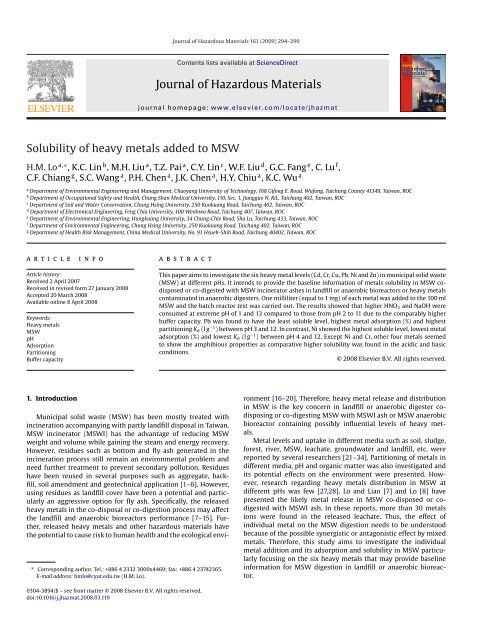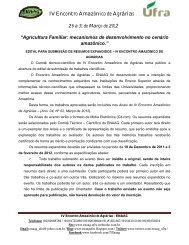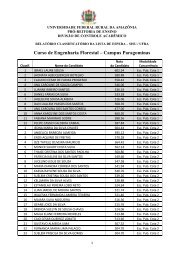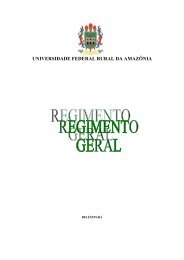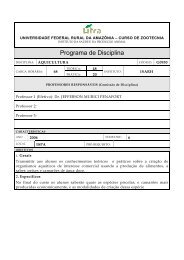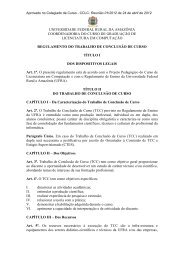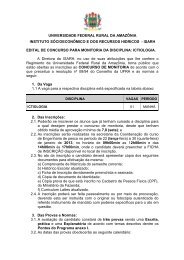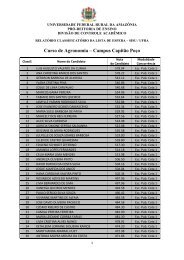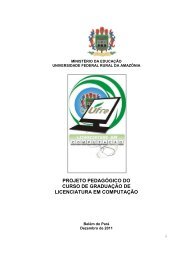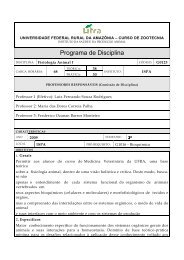Journal of Hazardous Materials Solubility of heavy metals ... - UFRA
Journal of Hazardous Materials Solubility of heavy metals ... - UFRA
Journal of Hazardous Materials Solubility of heavy metals ... - UFRA
You also want an ePaper? Increase the reach of your titles
YUMPU automatically turns print PDFs into web optimized ePapers that Google loves.
298 H.M. Lo et al. / <strong>Journal</strong> <strong>of</strong> <strong>Hazardous</strong> <strong>Materials</strong> 161 (2009) 294–299tration has been extensively reported [33]. The reported adsorbed<strong>metals</strong> were found higher than this study indicating MSW adsorptioncapacity was lower than these adsorbents such as peat, redmud, electric furnace slag and manganese nodules, etc. As expected,initial metal concentration (∼10–100 mg l −1 ) could affect the metaladsorption [33]. This phenomenon revealed that metal adsorptionwas found lower with initial metal levels <strong>of</strong> 10 mg l −1 in this investigationcompared to the report by Das and Jana [33]. Sorptionorder <strong>of</strong> maximum uptake <strong>of</strong> Cd > Pb > Ni > Cu by Foil et al. [34]and Fe > Zn > Cu > Ni > Cd by Erses et al. [27] also showed the differentresults compared to this study <strong>of</strong> Pb > Zn ≈ Cr>Cd>Cu>Ni.Metal solubility and adsorption can also be affected by the stepwiseformation constants [39] and functional groups such as carboxylicacids [28]; sulfhydryl groups, amino, carboxylate, imidazole andhydroxyl radicals <strong>of</strong> enzymes and other proteins [40]; amines, sulfategroups and carboxylic groups [41] and seven groups such asmercapto groups, uptake inside bacterial cells, carboxlic groups,phosphate and the like [42] therefore formed the different K d valuesfor different <strong>metals</strong> at each different pH. It was further notedthat metal could be adsorbed in dissolved organic matter such ashumic and fulvic acids [28] or solid matrix such as waste and sludge[23,27,34]. Thus, the metal adsorption constant (stability constant<strong>of</strong> metal–matrix complex) and K d value with detailed continuationresearch could be used to explain the metal adsorption scenariosin different environmental conditions such as pH, dissolvedorganic matter, adsorbent characteristics, and metal ions competition.In addition, these results can provide the baseline information<strong>of</strong> <strong>heavy</strong> metal levels for co-disposal or co-digestion process inlandfill or anaerobic digester.4. ConclusionsSoluble concentrations and adsorption <strong>of</strong> six <strong>heavy</strong> <strong>metals</strong> (Cd,Cr, Cu, Pb, Ni and Zn) in MSW with different pHs were investigated.Results showed that higher HNO 3 and NaOH were neededto reach to the extreme pH <strong>of</strong> 1 and 13 compared to that frompH 2 to 11 due to the comparable higher buffer capacity. Pb wasfound to have the least soluble level, highest metal adsorption (%)and highest partition K d (l g −1 ) between pH 3 and 12. In contrast, Nishowed the highest soluble concentration, lowest metal adsorption(%) and lowest K d (l g −1 ) between pH 4 and 12. Results also showedthat wider distribution patterns <strong>of</strong> metal adsorption versus solubleconcentration were observed in Pb and Zn while that was foundnarrower in Ni. Except for metal Ni, other five <strong>metals</strong> seemed toshow the amphibious properties as comparatively higher solubleconcentration was found in the rather acidic and basic pHs.AcknowledgmentsThe authors are grateful to the financial support from NationalScience Council, Taiwan, ROC. The contract no. <strong>of</strong> this grant is NSC94-2211-E-324-003.Appendix A. Supplementary dataSupplementary data associated with this article can be found,in the online version, at doi:10.1016/j.jhazmat.2008.03.119.References[1] R.J. Deschamps, Using FBC and stoker ashes as roadway fill: a case study, J.Geotech. Geoenviron. Eng. 124 (1998) 1120–1127.[2] R.E. Okoli, G. Balafoutas, Bottom ash from sludge cake as a barrier material topollutant migration in landfills, Waste Manage. Res. 17 (1999) 288–295.[3] M. Kamon, T. Katsumi, Y. Sano, MSW fly ash stabilized with coal ash for geotechnicalapplication, J. Hazard. Mater. 76 (2000) 265–283.[4] B. Marschner, A.D. Noble, Chemical and Biological processes leading to the neutralization<strong>of</strong> acidity in soil incubated with litter materials, Soil Biol. Biochem.32 (2000) 805–813.[5] F.S. Zhang, S. Yamasaki, M. Nanzyo, Waste ashes for use in agricultural production.I. Liming effect, contents <strong>of</strong> plant nutrients and chemical characteristics<strong>of</strong> some <strong>metals</strong>, Sci. Total Environ. 284 (2002) 215–225.[6] G. Qian, Y. Cao, P. Chui, J. Tay, Utilization <strong>of</strong> MSWI fly ash for stabilization/solidification<strong>of</strong> industrial waste sludge, J. Hazard. Mater. B129 (2006)274–281.[7] H.M. Lo, Y.L. Liao, The <strong>metals</strong>-leaching and acids-neutralizing capacity <strong>of</strong> MSWincinerator ash co-disposed with MSW in landfill sites, J. Hazard. Mater. 142(2007) 412–519.[8] H.M. Lo, Metals behaviors <strong>of</strong> MSWI bottom ash co-digested anaerobically withMSW, Resour. Conserv. Recycl. 43 (2005) 263–280.[9] G.F. Parkin, W.F. Owen, Fundamentals <strong>of</strong> anaerobic digestion <strong>of</strong> wastewatersludges, J. Environ. Eng. 112 (1986) 867–920.[10] M. Takashima, R.E. Speece, Mineral requirements for methane fermentation,Crit. Rev. Environ. Control 19 (1990) 465–479.[11] I.R. Leighton, C.F. Forster, The effect <strong>of</strong> <strong>heavy</strong> <strong>metals</strong> on a thermophilicmethanogenic upflow sludge blanket reactor, Bioresour. Technol. 63 (1998)131–137.[12] U. Alkaln, G.K. Anderson, O. Ince, Toxicity <strong>of</strong> trivalent chromium in the anaerobicdigestion process, Water Res. 3 (1996) 731–741.[13] C.Y. Lin, J. Chou, Y.S. Lee, Heavy metal-affected degradation <strong>of</strong> butyric acid inanaerobic digestion, Bioresour. Technol. 65 (1998) 159–161.[14] Z.B. Yue, H.Q. Yu, Z.L. Wang, Anaerobic digestion <strong>of</strong> cattail with rumen culturein the presence <strong>of</strong> <strong>heavy</strong> <strong>metals</strong>, Bioresour. Technol. 98 (2007) 781–786.[15] A. Espinosa, L. Rosas, K. Ilangovan, A. Noyola, Effect <strong>of</strong> trace <strong>metals</strong> on the anaerobicdegradation <strong>of</strong> volatile fatty acids in molasses stillage, Water Res. 32 (1995)121–129.[16] B.Y. Chen, K.L. Lin, Biotoxicity assessment on reusability <strong>of</strong> municipal solidwaste incinerator (MSWI) ash, J. Hazard. Mater. B136 (2006) 741–746.[17] B.Y. Chen, K.L. Lin, Dose-mortality assessment on municipal solid waste incinerator(MSWI) ash, J. Hazard. Mater. A139 (2007) 19–24.[18] K.L. Lin, B.Y. Chen, Understanding biotoxicity for reusability <strong>of</strong> municipal solidwaste incinerator (MSWI) ash, J. Hazard. Mater. B138 (2006) 9–15.[19] M. Meneses, M. Schuhmacher, J. Domingo, Health risk assessment <strong>of</strong> emission<strong>of</strong> dioxins and furans from a municipal waste incinerator: comparision withother emission sources, Environ. Int. 30 (2004) 481–489.[20] W.P. Watkinson, M.J. Campen, D.L. Costa, Cardiac arrhythmia induction afterexposure to residual oil fly ash particles in a rodent model <strong>of</strong> pulmonary hypertension,Toxicol. Sci. 41 (1998) 209–216.[21] R. Apak, J. Hizal, C. Ustaer, Correlation between the limiting pH <strong>of</strong> metal ionsolubility and total metal concentration, J. Colloid Interf. Sci. 211 (1999) 185–192.[22] K.G. Nierop, B. Jansen, J.M. Verstraten, Dissolved organic matter, aluminum andiron interaction: precipitation induced by metal/carbon ratio, pH and competition,Sci. Total Environ. 300 (2002) 201–211.[23] J. Wang, C.P. Huang, H.E. Allen, Predicting <strong>metals</strong> partitioning in wastewatertreatment plant influents, Water Res. 40 (2006) 1333–1340.[24] J. Wang, C.P. Huang, H.E. Allen, Modeling <strong>heavy</strong> metal uptake by sludge particulatesin the presence <strong>of</strong> dissolved organic matter, Water Res. 37 (2003)4835–4842.[25] S.A. Watmough, P.J. Dillon, E.N. Epova, Metal partitioning and uptake in centralOntario forests, Environ. Pollut. 134 (2005) 493–502.[26] C.A. Impellitteri, Y. Lu, J.K. Saxe, H.E. Allen, W.J.G.M. Peijnenburg, Correlation<strong>of</strong> partitioning <strong>of</strong> dissolved organic matter fractions with the desorption <strong>of</strong> Cd,Cu, Ni, Pb and Zn from 18 Dutch soils, Environ. Int. 28 (2002) 401–410.[27] A.S. Erses, M.A. Frazal, T.T. Onay, W.H. Craig, Determination <strong>of</strong> solid waste sorptioncapacity for selected <strong>heavy</strong> <strong>metals</strong> in landfills, J. Hazard. Mater. B121 (2005)223–232.[28] J.B. Christensen, T.H. Christensen, The effect <strong>of</strong> pH on the complexation <strong>of</strong> Cd,Ni, and Zn by dissolved organic carbon from leachate-polluted groundwater,Water Res. 34 (2000) 3743–3754.[29] C.E. Martínez, H.L. Motto, <strong>Solubility</strong> <strong>of</strong> lead, zinc and copper added to mineralsoils, Environ. Pollut. 107 (2000) 153–158.[30] P. Srivastava, B. Singh, M. Angove, Competitive adsorption behavior <strong>of</strong> <strong>heavy</strong><strong>metals</strong> on kaolinite, J. Colloid Interf. Sci. 290 (2005) 28–38.[31] P. Gundersen, E. Steinnes, Influence <strong>of</strong> pH and TOC concentration on Cu, Zn, Cd,and Al speciation in rivers, Water Res. 37 (2003) 307–318.[32] S.L. Simposon, B.M. Angel, D.F. Jolley, Metal equilibration in laboratorycontaminated(spiked) sediments used for the development <strong>of</strong> the wholesedimenttoxicity tests, Chemosphere 54 (2004) 597–609.[33] N. Das, R.K. Jana, Adsorption <strong>of</strong> some biavalent <strong>heavy</strong> metal ions from aqueoussolutions by manganese nodule leached residues, J. Colloid Interf. Sci. 293(2006) 253–262.[34] N. Fiol, I. Villaescusa, M. Martínez, N. Miralles, J. Poch, J. Serarols, Sorption <strong>of</strong>Pb(II), Ni(II), Cu(II), and Cd(II) from aqueous solution by olive stone waste, Sep.Purif. Technol. 50 (2006) 132–140.[35] M.S. Rao, S.P. Singh, Bioenergy conversion studies <strong>of</strong> organic fraction <strong>of</strong> MSW:kinetic studies and gas yield-organic loading relationships for process optimization,Bioresour. Technol. 95 (2004) 173–185.[36] K. Braber, Anaerobic digestion <strong>of</strong> municipal solid waste: a modern wastedisposal option on the verge <strong>of</strong> breakthrough, Biomass Bioenergy 9 (1995)365–376.
H.M. Lo et al. / <strong>Journal</strong> <strong>of</strong> <strong>Hazardous</strong> <strong>Materials</strong> 161 (2009) 294–299 299[37] J.C. García-Gil, S.B. Ceppi, M.I. Velasco, A. Polo, N. Senesi, Long-term effects <strong>of</strong>amendment with municipal solid waste compost on the elemental and acidicfunctional group composition and pH-buffer capacity <strong>of</strong> soil humic acids, Geoderma121 (2004) 135–142.[38] W. Ma, J.M. Tobin, Development <strong>of</strong> multimetal binding model and application tobinary metal biosorption onto peat biomass, Water Res. 37 (2003) 3967–3977.[39] C.N. Sawyer, P.L. McCarty, Chemistry for Environmental Engineering, McGraw-Hill, Inc., 1978.[40] S. Ren, P.D. Frymier, Kinetics <strong>of</strong> the toxicity <strong>of</strong> <strong>metals</strong> to luminescent bacteria,Adv. Environ. Res. 7 (2003) 537–547.[41] S. Peiffer, U. Becker, R. Herrmann, The role <strong>of</strong> particulate matter in the mobilisation<strong>of</strong> trace <strong>metals</strong> during anaerobic digestion <strong>of</strong> solid waste material, ActaHydrochim. Hydrobiol. 22 (1994) 130–137.[42] U. Becker, S. Peiffer, Heavy-metal ion complexation by particulate matter in theleachate <strong>of</strong> solid waste: a multi-method approach, J. Contam. Hydrol. 24 (1997)313–344.


